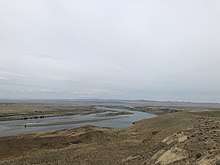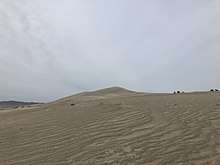Ringold Formation
The Ringold Formation is a geologic formation in Eastern Washington, United States. The formation consists of sediment laid down by the Columbia River following the flood basalt eruptions of the Columbia River Basalt Group reaching up to 1,000 feet (300 m) thick in places.[6][2] It preserves fossils dating back to the Neogene period.[7]
| Ringold Formation Stratigraphic range: Neogene | |
|---|---|
 The Columbia River flowing through the Ringold Formation. | |
| Type | Formation |
| Underlies | Deposits from Missoula Floods[1] |
| Overlies | Columbia River Basalt Group |
| Thickness | 1,000 feet (300 m)[2] |
| Location | |
| Coordinates | 46.667°N 119.436°W[3] |
| Region | Washington (state) |
| Country | United States |
| Type section | |
| Named for | Ringold School[4] |
| Named by | John C. Merriam, John P. Buwalda[5] |
Exposures of the Ringold Formation can be found from Hanford Reach National Monument north to the Moses Lake area.[5] Large portions of the formation are buried by other sediment deposits, extending as far as Wallula Gap southeast of Kennewick.[8] In recent years, irrigation water entering the groundwater system has destabilized some Ringold Formation slopes and cliffs, causing landslides.[9] The formation was named in 1917 for a school of the same name that existed at the time. Ringold School was located on the Franklin County side of the Columbia River to the south of Savage Island.[4][10]
Geology
During the flood basalt eruptions before the sediments were laid down, the Columbia River followed a different route than it does today, taking it near the present-day sites of Yakima and Goldendale. North-to-south compression of the Columbia Plateau caused anticline folds like Rattlesnake Mountain and the Horse Heaven Hills to rise. These ridges provided geographic barriers, rerouting the river eastward toward the Tri-Cities with it eventually flowing through Wallula Gap. The Ringold Formation is the sediment laid down after this course change took place.
Some of the sediments found as part of the formation may have been sourced from ancestral versions of other Pacific Northwest rivers like the Clearwater and Pend Oreille.[2] Layers of volcanic ash can also be found, with thicknesses ranging from being barely noticeable to 4 feet (1.2 m) thick.[8]
Stratigraphy
The Ringold Formation represents sand and gravel placed by the Columbia River between 9 and 3 million years ago. These deposits overlay cooled lava erupted as part of the Columbia River Basalt Group, a type of volcanic eruption known as flood basalts erupting from fissures across eastern Washington and Oregon that were unrelated to the Cascade Range.[11] It is covered in places by deposits from the Missoula Floods.
Regional uplift caused the Columbia to erode parts of the Ringold Formation. The White Bluffs on the Hanford Reach National Monument is a significant example of this.[6]
Landslides

Landslides along the Columbia River have increased in recent years due to irrigation around Basin City and Othello. Irrigation water enters and flows through the groundwater system toward the river easily through deposits left by the Missoula Floods. This destabilizes Ringold Formation features like the White Bluffs, causing the landslides.[9] Landslides did not occur frequently before 1960. Rapid changes in river flow caused by the Priest Rapids Dam upstream may also contribute to slope destabilization.[12]
The largest landslide in the White Bluffs portion of the formation is adjacent to Locke Island. This complex, initiated in the 1970s, has rerouted the Columbia River. As a result of the change, critical salmon spawning habitat has been destroyed. The landslide restricts the flow of the river on the east side of the river and as a result, large portions of Locke Island are being removed by the Columbia River. Movement of this landslide is ongoing, but the primary factor behind the continued movement is destabilization by the Columbia River eroding the fallen material. Blown sand from this landslide is the primary source material for sand dunes atop the bluffs near the island.[13][9]
The Locke Island slide is the northernmost slide along the White Bluffs. There are at least five other major slides into the Columbia River, with the southernmost one being across the river from Pacific Northwest National Laboratory in north Richland, which occurred in 2008. At least one slide has occurred in nearby coulees.[12]
Paleontology
The sediments include fossils from the Miocene. Along the Columbia River, fossilized remains of rhinoceros and salmonoid fish. The largest diversity of remains have been found among the White Bluffs, which are an exposed portion of the uppermost part of the formation. In addition to those that were discovered along the river, there are 27 additional species. These include smaller animals such as frogs and lizards as well as larger ones like horses, mastodons, and camels. Petrified wood can be found nearby.[2]
Several unique specimens have been found in the formation. An excavation done for a basement near Badger Mountain in Richland unearthed the northwesternmost example found thus far of Aphelops. This is also the only confirmed specimen of Aphelops in Washington.[14]
See also
References
- Michael Oard; John Hergenrather; Peter Klevberg (2006). "Flood transported quartzites: Part 2—west of the Rocky Mountains". Journal of Creation. Retrieved 2019-12-19.
- "Palentology - Hanford Reach". United States Fish and Wildlife Service. Retrieved 2019-12-19.
- David Hagen. "White Bluffs South". Washington Trails Association. Retrieved 2019-12-19.
- John C. Merriam; John P. Buwalda (1917). Age of strata referred to the Ellensburgh formation in the White Bluffs of the Columbia River. University of California.
- J. ERIC SCHUSTER; CHARLES W. GULICK; STEPHEN P. REIDEL; KARL R. FECHT; STEPHANIE ZURENKO (1997). "Geologic Map of Washington - Southeast Quadrant" (PDF). Washington State Department of Natural Resources. Retrieved 2019-12-20.
- "Columbia River". United States Fish and Wildlife Service. Retrieved 2019-12-19.
- Various Contributors to the Paleobiology Database. "Fossilworks: Gateway to the Paleobiology Database". Archived from the original on 31 July 2014. Retrieved 8 July 2014.
- R. C. Newcomb (1958). "RINGOLD FORMATION OF PLEISTOCENE AGE IN TYPE LOCALITY, THE WHITE BLUFFS, WASHINGTON" (PDF). Washington State Department of Natural Resources. Retrieved 2019-12-20.
- "A Geological Paradise". Reach Museum. Retrieved 2019-12-19.
- C.P. McKinley (1922). Hanford Quadrangle (Map). 1:62,500. United States Geological Survey. Retrieved 2019-12-20.
- "Columbia River Basalt Group Stretches from Oregon to Idaho". United States Geological Survey. Retrieved 2019-12-19.
- Bruce N. Bjornstad; Robert E. Peterson. "Hydrogeologic Controls and Impacts of Quaternary Landslides Along the White Bluffs of the Columbia River, South-Central Washington" (PDF). Pacific Northwest National Laboratory. Retrieved 2019-12-20.
- B. N. Bjornstad (2006). "Past, Present, Future Erosion at Locke Island" (PDF). Pacific Northwest National Laboratory. Retrieved 2019-12-20.
- Eric P. Gustafson (2012-05-01). "New Records of Rhinoceroses from the Ringold Formation of Central Washington and the Hemphillian-Blancan Boundary". Journal of Vertebrate Paleontology. Retrieved 2019-12-19.